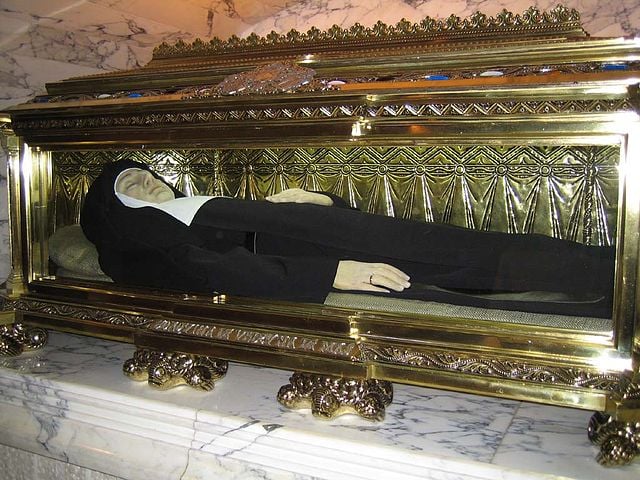
(2-26-09)
***
This is a follow-up post to my previous entry, “Biblical Evidence for Candles, Incense, and Related Sacramental Symbolism for Prayer and Sacrifice.” Nick, a Protestant, has been very active in the combox for that post. I wanted to interact with some of his statements there. His words will be in blue.
* * * * *
[Note: the last section of the paper above on candles, concerning “lamps” and “lampstands” (“candles” and “candlesticks” in KJV) was added after the initial exchange. So some of Nick’s initial criticisms about “explicit biblical support” for candles have now been completely overcome. He is also, part of the time, responding to another person; hence the mixture of first and third person address]
***
Not a single verse you quote mentions candles. Not one.
I didn’t claim they did, so that is a moot point.
The first three (1 from Genesis, 2 from Leviticus) are in reference to OT sacrifices/offerings to God . . . something no Christian church does.
That wasn’t the main analogy in those passages, as I saw it (though I didn’t state this): which was to the “pleasing odor” to the Lord, which is similar to the incense in revelation as symbolic of prayer. There are multiple layers of types and shadows here.
The other four refer to incense. Luke’s reference is to incense in the Jewish Temple, due to a Jewish ceremony being held there,
That’s why my first “summary” statement was the following:
Incense (i.e., a thing that burns and produce smoke and fragrances, which is similar to a candle, complete with the metaphorical smelling of the offering by God), as an image of prayer, is an explicit biblical motif.
What is biblically explicit is a burning thing that represents prayer. Later, I did find that candles themselves are explicitly mentioned, too, because I had somehow overlooked the menorah and lampstands of Hebrew worship.
and the two passages in Revelation are symbolic. The three verses from Paul are clearly metaphors.
The prayers of the saints in those passages are not metaphorical. The smoke of the incense is indeed a metaphor for prayer, which is exactly my argument. Candles are closely aligned to that, in my opinion, as I have argued.
It’s certainly not indicative of something “sacramental,” i.e. an actual physical thing that confers grace.
I meant “sacramental” in the very widest sense, which would be use of physical things. A candle in a Catholic church is indirectly a sacramental insofar as it entails a physical action that can be a blessing in some sense to the person who lights one. And they would have been blessed by a priest. So they are sacramentals, as opposed to sacraments.
I’m not claiming that candles are sinful, wrong, or that we should remove them from churches, but for you to claim that there’s “explicit” support for them in the Bible is a bit much.
I have now produced ten prooftexts that refute your contention (and many cross-references also). My initial research was simply incomplete, whereas your assertion is flat-out false, and falsified in the Bible.
A Christian service void of candles is not incomplete or un-Biblical, by any stretch of the imagination.
I didn’t make that claim, either. The purpose was to explain and justify one Catholic practice, not to run down non-Catholic worship (from which I have received a great deal in my Christian life).
I’m not opposed to the use of candles at all (along with many Protestant churches), but the Bible is basically silent on their use in Christian churches, and I just wanted to make that point. . . . the Bible is SILENT on the issue. Therefore, I make no judgement on a church, or on the Biblical soundness or validity of a given service, based on the presence or absence of candles in that service. . . . As I already said, I don’t have a problem with candles. I am not in the least making it a “moral issue.” Dave, in my opinion, made way too much of the indirect, metaphorical use of God smelling “fragrances” in the Bible to justify using candles in church. That doesn’t mean the use of candles is “wrong,” just that his Biblical defense of it wasn’t particularly strong.
It’s not “silent” at all, as I have shown.
Different people find beauty in different things; some people find beauty in very complex, fancy art, and others find beauty in very simplistic art. Also, “Protestant art” covers a huge range of forms, from very detailed and “Catholic” in style – with candles, incense, statues, and the like, to the very simplistic – perhaps a church composed of just one rectangular room with plain walls and a single cross behind the pulpit. . . . Personally, I don’t find one more inherently sinful or another more inherently spiritual. God is far more concerned with the hearts within the people in the church than what the architecture of the church is. I also understand that, for you, a candle during Mass or some other church service may represent Christ, or some other perfectly orthodox and Biblical principle. Many Protestant churches, including mine, also utilize candles in their own services. My concern (and I think, that of Protestantism in general) lies in the fact that too much emphasis can be placed on such earthly accessories. Candles don’t make us holy. If you want to light a candle in church and that represents something significant to you, cool. But having the idea in your head that that candle somehow makes you holy, or the place where you are worshipping more holy, or it gives it a “holy feel,” seems to demonstrate a huge misunderstanding of what holiness is and from whence it comes. As for “elemental” components in religious services are concerned, I’m not terribly convinced that we should include things in Christian church services just because Buddhists and Hindus are. For me that’s not really a detriment to Protestantism; it’s a selling point. But perhaps you or someone else can convince me otherwise.
The local Catholic church is a holy place precisely because we believe Jesus is there Body, Soul, Spirit, and Divinity. Now, I understand that you probably do not believe that to be the case, but it is our belief, and that’s why we think the sanctuary is holy: it is Christ-based.
That is a sacramental understanding indeed, just as the Incarnation was sacramental: God took on matter and so sanctified it by having human flesh. You and every orthodox Protestant believe in the Incarnation. Protestants (even very “low church” ones) are not entirely unsacramental. It is easy to demonstrate this. You usually have a cross in your church somewhere. There is often stained glass. Not many Protestant churches have bare white walls, Puritan-style. Protestants speak of the blood of Christ.
It depends what you mean when you say they are “sacramental.”
I’ve explained that above. Protestants are sacramental to various degrees. Martin Luther, the founder of Protestantism, was very sacramental; he believed in the Real Presence in the Eucharist and regenerating baptism.
Protestants often utilize physical things to serve as symbols for those who are worshipping, yes. You earlier said that the term “sacramental” in its “widest sense” simply means, “use of physical things.” So yes, in that sense pretty much everyone and their mother is “sacramental.”
Agreed.
But that’s a bit of a misleading definition when you’re trying to defend Catholic “sacramentalism,” because when Catholics refer to the “sacraments” and being “sacramental,” they rarely mean it in this “widest” sense.
Sometimes we do; other times we don’t.
Earlier you said that candles in a Catholic church can be a “blessing” to one who lights them, and that they have been blessed by a Catholic priest. This seems to entail more than mere symbology, no?
Yes, but it is distinct from, say, the Eucharist, which is inherently efficacious if received properly (i.e., without mortal sin). Sacramentals are effective (and in a far lesser sense than one of the seven sacraments) only insofar as a person’s internal disposition is proper.
You don’t think you are sacramental? Okay; let me ask you: if you had a vial of Christ’s blood (grant that we are sure it is His), would you treat it like any other blood? Would you throw it down the drain, to enter the sewer? If not, why?
This hypothetical of course hinges on the huge “if” of whether or not we literally have a vial of Christ’s blood drained from His physical body.
You have dodged the question (and I understand why). Hypotheticals (by nature) involve granted assumptions, as I made clear was the case with mine. We are granting for the sake of argument that it is Christ’s blood. Now, how would you treat it? It’s the “horns of a dilemma” for you, as they say in classical logic. I don’t think you would throw it down the drain like any other blood. I doubt that one Protestant in a hundred would do that. They just wouldn’t do it. I think you (and they) would revere it and treat it with the greatest respect; and to the extent that you do that you are already approaching some particular matter (our Lord and Savior Jesus Christ’s blood) as Catholics do: in the sense that some matter can convey more grace and be “spiritual” or “special” more than other matter. When Protestants refer to the blood of Christ, they get this. But in other instances they forsake the principle that they themselves accept in the example of the blood of Christ.
Would you bulldoze the site of the cross and Golgotha / Calvary and make a parking lot or a drugstore, as if it had no more significance than any other place on earth? I highly doubt it.
No, . . .
There you go. See, I knew you wouldn’t do it, and you wouldn’t with Jesus’ blood, either. Now you have to ask yourself why. The reasons you would come up with for not doing it would either be the same reasoning Catholics apply, or at least somehow leaning in our direction.
but would you kneel down and kiss the dirt on that hill?
Yes, absolutely. Protestants often kiss the Bible. What earthly reason could they give for not kissing the very ground our Lord died for us on? You’ll kiss God’s verbal revelation and written Word, but not the place where the Word, Jesus, died for you? That makes no sense. Why would you kiss the one thing and not the other? What is the difference in principle? But I say that if you kiss a Bible (or, say, a photograph of a son slain in military service), there is no inherent objection to kissing the dirt of Calvary.
Would you collect some of that dirt and take it home with you, and kiss it at night when you say your prayers? Would you try to find some splinter of the cross you think Christ was crucified on, and kiss and revere that?
Absolutely; by the same principles: because we know from the Bible that matter can convey grace. It’s very straightforward (I’m surprised that you don’t seem to know about it):
2 Kings 13:20-21 So Elisha died, and they buried him. Now bands of Moabites used to invade the land in the spring of the year. 21 And as a man was being buried, lo, a marauding band was seen and the man was cast into the grave of Elisha; and as soon as the man touched the bones of Elisha, he revived, and stood on his feet.
The bones or relics of Elisha had so much supernatural power or “grace” in them that they could even cause a man to be raised from the dead.
2 Kings 2:11-14 And as they still went on and talked, behold, a chariot of fire and horses of fire separated the two of them. And Elijah went up by a whirlwind into heaven. And Elisha saw it and he cried, My father, my father! the chariots of Israel and its horsemen! And he saw him no more. Then he took hold of his own clothes and rent them in two pieces. And he took up the mantle of Elijah that had fallen from him, and went back and stood on the bank of the Jordan. Then he took the mantle of Elijah that had fallen from him, and struck the water, saying, Where is the Lord, the God of Elijah? And when he had struck the water, the water was parted to the one side and to the other; and Elisha went over.
Acts 5:15-16 . . . they even carried out the sick into the streets, and laid them on beds and pallets, that as Peter came by at least his shadow might fall on some of them. 16 The people also gathered from the towns around Jerusalem, bringing the sick and those afflicted with unclean spirits, and they were all healed.
Acts 19:11-12 And God did extraordinary miracles by the hands of Paul, so that handkerchiefs or aprons were carried away from his body to the sick, and diseases left them and the evil spirits came out of them. (cf. Mt 9:20-22)
Elisha’s bones were a first-class relic: from the person himself or herself. These passages, on the other hand, offer examples of second-class relics: items that have power because they were connected with a holy person (Elijah’s mantle and even St. Peter’s shadow), and third-class relics: something that has merely touched a holy person or first-class relic (handkerchiefs that had touched St. Paul). Another example would be the woman healed by touching the hem of Jesus’ garment (which would be analogous to a piece of the cross, or His blood):
Mark 5:25-30 And there was a woman who had had a flow of blood for twelve years, and who had suffered much under many physicians, and had spent all that she had, and was no better but rather grew worse. She had heard the reports about Jesus, and came up behind him in the crowd and touched his garment. For she said, “If I touch even his garments, I shall be made well.” And immediately the hemorrhage ceased; and she felt in her body that she was healed of her disease. And Jesus, perceiving in himself that power had gone forth from him, immediately turned about in the crowd, and said, “Who touched my garments?”
Luke 8:43-48 And a woman who had had a flow of blood for twelve years and could not be healed by any one, came up behind him, and touched the fringe of his garment; and immediately her flow of blood ceased. And Jesus said, “Who was it that touched me?” When all denied it, Peter said, “Master, the multitudes surround you and press upon you!” But Jesus said, “Some one touched me; for I perceive that power has gone forth from me.” And when the woman saw that she was not hidden, she came trembling, and falling down before him declared in the presence of all the people why she had touched him, and how she had been immediately healed. And he said to her, “Daughter, your faith has made you well; go in peace.”
Jesus did say also that her faith was what made her well, but the point is that it was also with the aid of a physical object that was in contact with Jesus: as indicated precisely by its effect of causing “power” to go “forth from him.” God used the physical object for spiritual (and supernatural physical) purposes: a healing. We see it again, when Jesus heals the blind man:
John 9:6-7 As he said this, he spat on the ground and made clay of the spittle and anointed the man’s eyes with the clay, saying to him, “Go, wash in the pool of Silo’am” (which means Sent). So he went and washed and came back seeing.
Jesus could have simply declared him healed, with or without the man’s faith playing a key role (as He healed both kinds of people): it could have been a wonderfully Protestant, purely “spiritual” healing, with no material object used. But, interestingly enough, Jesus didn’t do that. He used a bodily fluid (his own), and also clay, or dirt, and then the water of the pool, and rubbed the man’s eyes, to effect the miracle (two liquids, solid matter, and physical anointing action of fingers). Obviously, then, we can’t frown upon physical things related to a holy person in some fashion, in order to perform a miracle. The example is too clear. What more proof does one require?
This is exactly how Catholics view relics. Why, then, do you frown upon these practices, and regard them as foolish, excessive, and unbiblical, with all of this clear biblical proof of them? If you claim to follow what the Bible teaches, I’ve just shown it to you, with regard to physical means of grace, and specifically relics.
I’ve written about the altogether insubstantial Protestant arguments that attempt to overthrow this plain biblical data.
Would you think the presence of those things would make your house more “holy,” simply by being there when you pray? We can both cite extreme examples in either direction.
It’s not extreme at all. There are such things as holy objects and holy places. The ark of the covenant was one such thing. It was so holy that a man could die by just touching it (and the Bible records one such incident). The tabernacle which contained the ark was holy, as was the temple (which had the holy of holies inside of it). Wherever God is, is holy (e.g., the “holy ground” near the burning bush: Exodus 3:5). It’s because Protestants don’t believe that God can be specially present (not just in his omnipresence); even physically present, anymore, that they don’t believe in holy places. We do; because we follow the Bible far more closely than you do.
When I searched for the phrase “holy place” in RSV, for the whole Bible, it came up with 70 matches (taking out 15 from the Deuterocanon that you don’t accept). And that includes NT proof: Jesus referred to a “holy place” in Matthew 24:15. Paul used the analogy of Christians being temples (and therefore holy), because of the indwelling Holy Spirit inside of us:
1 Corinthians 3:16-17 Do you not know that you are God’s temple and that God’s Spirit dwells in you? If any one destroys God’s temple, God will destroy him. For God’s temple is holy, and that temple you are.
1 Corinthians 6:19 Do you not know that your body is a temple of the Holy Spirit within you, which you have from God? You are not your own;
2 Corinthians 6:16 . . . For we are the temple of the living God . . .
Erasmus was quite put off by the hyper-sacramentalism of Rome when he visited there. I can’t remember the exact quote, but he said something to the effect that, “After all the shoes that we’ve had to kiss, are you going to bring us the dung of a saint to kiss as well?” The point is, too much can be made of these “sacramental” elements that are included in church services.
Sure, there have been excesses (I freely acknowledge them; people being people, and prone to extremes), but that doesn’t nullify the biblical principle of relics and sacramentalism. We don’t throw out the baby with the bathwater. Erasmus wouldn’t have denied that. He claimed many times that he accepted all that the Church taught (I know, because I recently studied one of his primary writings: the Hyperaspistes).
And you wouldn’t [toss out Jesus’ blood or bulldoze Calvary] because you have a sense of the sacred and of holy places, even though you may wish to argue against it when Catholics refer to it.
Don’t assume that I’m rejecting anything just because “a Catholic said it.” Catholics can make perfectly valid points in theological discussions as well. What I argue against is the near-obsession that many Catholics have with physical objects of adoration.
You have neither shown that it is always an obsession, nor that it is unbiblical, whereas I have shown that the justification is quite explicitly biblical; thus, that there is a proper use of this sort of piety and devotion.
I am not trying to argue against the sense of “sacramental” that you described earlier, if I understand what you meant. What I am trying to say is simply that the inner spirituality of a church is more important than its outer adornment. Fair enough?
But you want to deny the validity of relics and holy places, when the Bible doesn’t do that at all. We fully agree with you that the inner disposition and the heart is fundamentally important. That’s why we teach that it is a great sin to partake of Holy Communion in a state of mortal sin, and that absolution after confession can’t take place if the person wasn’t truly repentant. We don’t dichotomize the “inward” and “outward” elements. But Protestants so often want to eliminate the physical, outward elements altogether, because their spirituality is not large enough to imagine a harmonious conjunction of both. They tend to equate “spirit” with good and matter with evil, as the ancient Gnostics and Docetics did. But that is a far more pagan Greek attitude (the folks who didn’t like the Resurrection because it was physical) than Christian and biblical.
Candles reflect this holiness because the symbol of ascending smoke for prayer and sacrifice is a biblical motif, as I have shown, and part of the practice of Jews and Christians for at least four millennia.
We don’t think a candle makes us holy. That is ridiculous. We think it helps foster an atmosphere of reverence and sacredness, just as stained glass, statuary, stations of the cross, etc. do. I myself have found that I am able to far more easily and deeply, reverently worship and concentrate on worshiping Jesus in my German Gothic cathedral parish than in the YMCA gyms that I sometimes worshiped in as a Protestant, and that is because beauty and truth are closely related. The beautiful fosters reverence.
Catholicism uses human impulses that are morally neutral and co-opts them for Christ. It utilizes whatever in paganism is a good thing (or at least neutral and not bad) and “baptizes” it for Christianity. The Apostle Paul did this on Mars Hill in Athens (Acts 17:16 ff.). He commended the Athenians for their religiosity and the tomb to the unknown god (17:22-23), cited two of their poets / philosophers (17:28), and, building upon that knowledge, proclaimed the gospel to them (17:23-31). He didn’t run their present knowledge down as heathen garbage, but rather, used it as a bridge to the gospel.
The Catholic Church does the same in many many ways. It’s sacramentalism and incorporation of beauty and physical objects into worship. That’s been done in our (Judaeo-Christian) religious tradition all the way back to the Temple and Tabernacle. God Himself used fire in the burning bush as a symbol of himself when He appeared to Moses. He used the physical object. He appeared in theophanies as a man or as the “angel of the Lord.” It’s nothing new. To the extent that Protestantism rejects all that it is being most unbiblical and against the same mode of thought that the Incarnation is included in (physical matter conveying grace).
Christ does not want you to kiss the ground where He once stepped.
Then why are you reluctant to bulldoze Calvary, if it is not a whit different than any other place on earth? Why is it that Protestants, just as much as Catholics, love to go to the Holy Land? Why bother? If it is no different from any other place, and physical conjunction with Jesus or holy men and women is utterly irrelevant, and there is no such thing as a holy place, why do they go there? That’s a Catholic idea. They implicitly accept the notion of the “holy place.” So do you. But you inconsistently apply it. You won’t kiss the ground of Calvary, but on the other hand you wouldn’t bulldoze it.
Well, if you want to preserve it because it is valuable and has meaning, what in the world is the objection to kissing it? We kiss dogs and inanimate objects that we love. You can’t produce any saying of Jesus, where He said to not do this. But I already produced an instance of touching His garment, which brought about healing in conjunction with faith. Jesus obviously believed in the holiness of the temple because He said it was His father’s house. He accepted it when the woman kissed His feet (Lk 7:38,45). Why not the ground that He died on? I say your spirituality is insufficiently incarnational and too influenced by Docetism, with all this antipathy to matter and how God uses it for spiritual purposes.
He would much rather that you obeyed His commands and used His life of love and servitude as an example to love and serve others.
This is a false dichotomy. Of course those things are commands, but pious acts involving matter are eminently biblical. It is you who have a problem with the Bible’s teaching in this regard.
My whole point is, I question just how balanced Catholicism truly is. It seems to me that there is far too much emphasis (perhaps just in individuals, not in the system officially) on the outwardness, and very little inwardness. Personally I think inwardness has to be the individual’s focus first, when one is a Christian. Going through outward motions isn’t progressing anyone spiritually. Rather, meditation/prayer, Bible study, yielding to the Holy Spirit and allowing Him to bear fruit in our lives…THOSE are the things that must come first. If we are “right” inward, the outward expressions of our inward growth will come.
We agree wholeheartedly that the inward elements are supremely important. We simply refuse to pit them against outward, sacramental, physical things, as you do. We keep both in balance, because God became man, and so sanctified matter. You practically eliminate one or so emasculate it that little good is said about it, in relation to spirituality. That’s where any imbalance lies. Yet Jesus’ very death on the cross and His Resurrection are intensely physical things.
If you understand the definition of a church to be a body of believers, then you’re going to focus on the inner spirituality of that “church.” My point was that the latter is preferable to the former.
Case in point: yet another Protestant dichotomy. The Bible uses “Church” in both senses, and we adhere to both. We don’t have to choose between them and “pick sides.” Both are important. It’s the biblical “Both/and” outlook; not the Protestant “either/or” mentality.
As I said, if you’re focus is on external THINGS, objects that you think are going to get you closer to God, then you’re not going to be focused on the internal things that Christ found so much more important (it’s not the things that go into a man that make him unclean, but the things that come out of him, out of the heart the mouth speaks, etc.) So yea, you can light a candle. But that candle doesn’t make you more holy. It doesn’t make you more spiritual. Kissing dirt where Jesus once walked doesn’t make you closer to Him or more like Him. Doing as He did, walking as He walked (through yielding to the Spirit), THAT makes you more like Him.
More false dichotomies. You reason, “because thing A is good; therefore, different thing B is not good, or less good than A.” But we reason, in accordance with the Bible: “God has revealed that both A and B are good things, so why must folks pit them against each other?”
We agree wholeheartedly with you about wholehearted devotion to God, in righteousness and holiness and right motive. That’s all wonderful. We don’t disagree with any of it. Read The Imitation of Christ some time if you want to see a Catholic treatment of that. It’s fabulous. But you disagree with sacramentality and physical objects used for spiritual purposes (you seem to collapse every instance of it into extremity and inferior spirituality). I have shown that this is a most unbiblical position to take. Your burden now is to refute the biblical arguments provided. Your fight in this respect is not ultimately with Catholics, but is, I believe, with the Bible and with the God Who wrote the Bible, and how He chose to do and reveal things.
A certain forum dominated by cynics and relentless critics of anything I do has a thread devoted to mocking and making ridiculous comments about the photograph posted at the top of this dialogue [initially it was a depiction of the Passion of Jesus]. This mentality highlights once again the odd Protestant antipathy to physical things in Christianity: even, in this case, the nature of the crucifixion itself.
The nice European, blond-haired, blue-eyed Jesus (who looks sort of like a guy in a 70s country rock band: like Kenny Rogers or something), used to be mocked, and rightly so. But let anyone dare show what truly happened when He was beaten and crucified for our sake, and sure enough, that has to be made fun of with idiotic remarks, as if a Catholic enjoys and gets a charge out of seeing what they did to our Lord and Savior (in other words, that it is — what else? — abnormal, mentally questionable behavior). I can understand agnostics saying this (it is one of their brain dead, garden-variety blasts against Christianity), but other Christians? Very odd and strange. The entire point is missed, as usual.
I didn’t make the crucifixion what it is. But I know it is good and pious to meditate upon the suffering of Jesus for our sake. Paul did that so much that he writes about taking into his own body the sufferings of Christ (2 Cor 4:10, Col 1:24) and that Christians are to share His sufferings (Rom 8:17; Phil 3:10). I guess, then, he is about as morbid as they come: obsessed with all the blood and gore, etc. We’ll have to give Paul a Protestant, secularist American re-education and get him up to speed. Meanwhile, look at the violent movies our culture produces. That’s fine and dandy. Instead it is considered chic and intelligent and sophomoric-clever to mock a Catholic meditation on the central event in the Christian faith, as if this were not a thoroughly Christian and “biblical” thing to do.
But whatever we do, we dare not meditate on the cross! We can’t have that. We must have a sanitized, bleached, streamlined feel-good, warm fuzzy, non-physical religion, just like the Gnostics and Greek pagans did. We must forget the cross at every turn. It’s too bloody. We can only have a bare cross or one with a Jesus on it who looks like he is from a junior high play. These cynics want to be more like pagan Greeks than Christians in this respect, like the ones St. Paul commented upon: “but we preach Christ crucified, a stumbling block to Jews and folly to Gentiles” (1 Corinthians 1:23).
As it is, the main reason I posted the “bloody picture” was because it had a direct relationship to one of the arguments in the paper: about the blood of Christ and how a Protestant would treat it if he had a hypothetical vial filled with it. But I don’t expect that to be grasped, either, by folks who consistently show a profound inability to comprehend what I write, or what my argument is, or even my reason for making any particular argument. Even my explaining it now won’t matter a hill of beans, because hostility clouds one’s intellectual capacities and makes one illogical, as well as silly beyond words.













